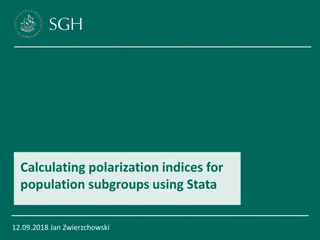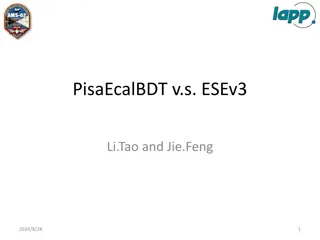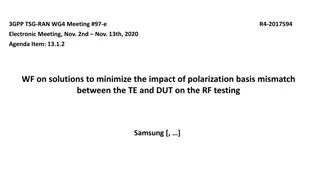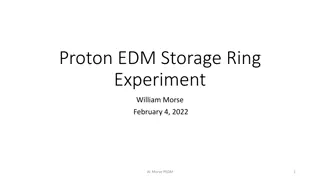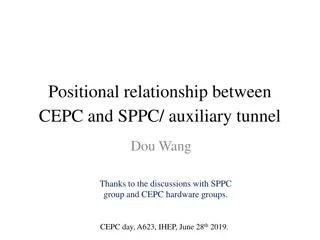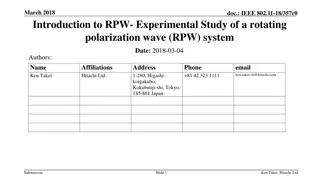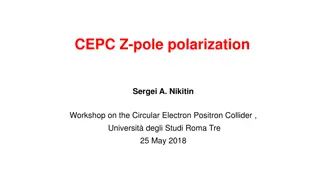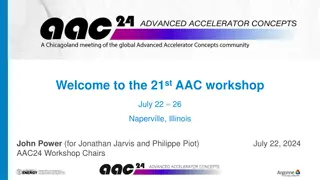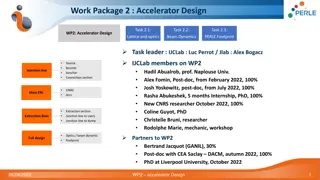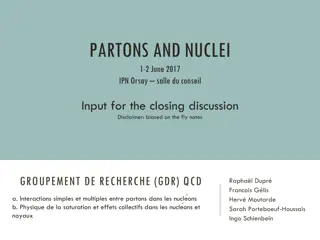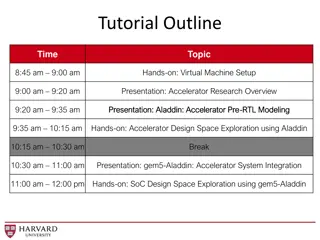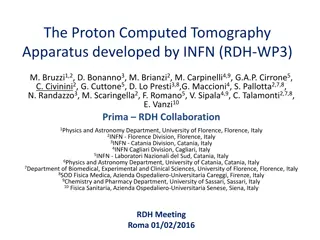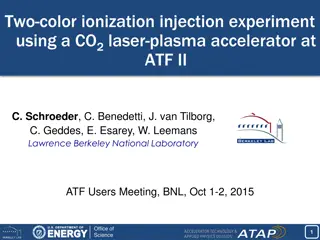Measuring Proton and Antiproton Polarization at U70 Accelerator
Absolute polarimeters are described for the beam channel at U70 Accelerator in Russia, focusing on transporting polarized proton and antiproton beams. Various polarimeters are discussed for measuring proton and antiproton polarization, including diffraction and interference-based techniques. The experimental data for diffraction polarimeter at 45 GeV/c is presented, along with kinematics parameters for polarimetry measurements.
Download Presentation

Please find below an Image/Link to download the presentation.
The content on the website is provided AS IS for your information and personal use only. It may not be sold, licensed, or shared on other websites without obtaining consent from the author.If you encounter any issues during the download, it is possible that the publisher has removed the file from their server.
You are allowed to download the files provided on this website for personal or commercial use, subject to the condition that they are used lawfully. All files are the property of their respective owners.
The content on the website is provided AS IS for your information and personal use only. It may not be sold, licensed, or shared on other websites without obtaining consent from the author.
E N D
Presentation Transcript
A.A. Bogdanov1 , M.A. Chetvertkov2, V.A. Chetvertkova2, B.I.Garkusha3, A.P. Meshchanin3 , V.V. Mochalov3, M.B. Nurusheva123, S.B. Nurushev13, A.V. Ridiger2,V.L.Rykov1 , P.A. Semenov 3 ,M.N. Strikhanov1, A.N. Vasiliev3, V.N. Zapolsky3 (1) National Research Nuclear University MEPhI, Moscow, Russia (2) Federal state budget organization State center Interphysica, Ministry of education and science, Moscow, Russia (3) State Research Center of Russian Federation -Institute for High Energy Physics, Protvino, Russia E-mail: bogdanov411@mail.ru
Contents 1. Task 2. Polarimeters for measuring proton polarization. 2.1Diffraction polarimeter. 2.2Interfirience polarimeter. 2.3Combined polarimeter. 3. Polarimeters for measuring antiproton polarization. 3.1 Elastic ppbarscattering 3.2 Inclusive 0, 4. Conclusion
1. TASK We describe the absolute polarimeters for the beam channel intended to transport the polarized proton/antiproton beam at U70 accelerator. The circulating proton beam of 60 GeV/c and intensity of 1013p/cycle is slowly extracted from accelerator. It strakes the external an aluminum target of one interaction length. Emitted and hyperon serve as source of polarized p and pbar, with momentum from 10 40 GeV/c with intensity, approximately 104 4 105antiprotons/cycle, 106protons/cycle ]
2. Polarimeters for measuring proton polarization. 1. Polarimeter based on pp elastic scattering 0.04 |t| 0,5 (GeV/ )2. Diffraction cone. 2. Polarimeter based on pp elastic scattering in CNI region. 0.002 |t| 0,05 (GeV/ )2. 3. Combined polarimeter. 0.002 |t| 0,5 (GeV/ )2.
Diffraction polarimeter Polarization has been measured at U70 for pp elastic scattering at 45 GeV/c. A. Gaido et al., Phys. Lett. 61B (1976)104 J.C. Raquel te al., Nucl. Instr. And Methods 125 (1975) 585 Fig. 2. Experimental data at 45 GeV/c. Table 2. Experimental data at 45 GeV/c
Table 3. Kinematics parameters of diffraction polarimeter t (Gev/c)2 =signal/(signal+backgrou nd) M=P2*(d /dt), b/(G eV/c)2 T, =signal/signal scatterin g, grad recoil , grad max (0.04 0.075) 38,7 0.285- 0.395 81.5-84 (21-40) 0,993802 1 (0.075 0.125) 18,9 0.39-0.51 79.07-81.5 (40 67) 0,984301 0,912958 (0.125 0.175) 0.51-0.60 77.13-79.08 (67-93) 0,977868 0,535022 7,7604 (0.175 0.225) 0.60-0.69 75.47-77.13 (93-120) 0,967702 0,31275 5,2887 (0.225 0.275) 0.69-0.76 74.01-75.47 (120-147) 0,959285 0,184704 1,5654 (0.275 0.325) 0.76-0.82 72.69-74.01 (120-173) 0,944408 0,107838 1,7861 (0.325 0.375) 0.82-0.88 71.49-72.69 (173-199) 0,923676 0,063056 0,2088 (0.375 0.425) 0.88-0.94 70.38-71.49 (199-226) 0,883977 0,0355 0,1071 (0.425 0.475) 0.94-0.99 69.33-70.37 (226-253) 0,861419 0,022025 0,0738 (0.475 0.525) 0.99-1.05 68.37-69.33 (253-280) 0,813561 0,012648 0,0303
Rate and time for 10% accuracy L= I Na x= 0,7 1029 m-2s-1 =0,07- number of cycles per second. I=106p/cycle - beam intensity in cycle, =0,07 g/ m3 target density, x=20 cm target length. p/hour t0= 0,22 (GeV/ )2 d /dt(t0 0,22) = (8,326 0,073) mb/(GeV/c)2 t=0,03(GeV/ )2, / =0,17
Rate and time for 14% accuracy PB = / / AN. [ ( PB)/ PB]2= [ ( )/ ]2+ [ (AN)/AN]2 ( )/ = = (AN)/AN AN=(2,2 0,2)%. =0,1 =0,1PBAN =0,88 10-3 PB=0,4, AN = 0,022 N=1/( )2= 1.29 106events Accuracy in beam polarization 14%
Interference polarimeter Polarization at 45 GeV/c ( s=9.3 GeV) was not measured in CNI region. We use data from STAR experiment at RHIC BNL at s=6,8, 7,7, 13,7, 21,7 GeV. Fig. 6. Experimental data of analyzing power in CNI region measured at RHIC.
Analyzing power can be expressed in following way To calculate analyzing power at sqrt(s)=9.3 GeV we have to calculate Rer5 and Imr5. We use power law to fit data of STAR experiment. p0, p1- fit parameters, s0=1 GeV2
Fit results Fig. 7b. Fig. 7a. Fig. 7 Fit of Rer5 (Fig. 7a) and Imr5(Fig. 7b) 9.3 (6.8,7.7, 13.7) 0.004 0.006 0.04 0.09 6.8 -0.008 -0.109 7.7 -0.055 -0.016 13.7 -0.0008 -0.015 21.7 -0.002 -0.005 Rer5 Imr5
Analyzing power in CNI region at s=9.3 GeV Fig. 8. Analyzing power in CNI region at s=9.3 GeV
Rate and time for 10% accuracy Can be calculated in same way as for diffraction polarimeter 0.65 10^4 p/hour L= I Na x= 0,7 1029 m-2s-1 t0= 0,0134 (GeV/ )2 d /dt(t0 0,0134) = (67,4 0,073) mb/(GeV/c)2 t=0,0023(GeV/ )2, / =0,17 AN=(0,03 0,01)%. =0,1 =0,1PBAN =1,2 10-3 PB=0,4, AN = 0,03 N=1/( )2 = 0.7 106 ? ?(?0)= 107.7 ??? ? =
Combined polarimeter Fig. 9. Combined polarimeteron channel 24A. Diffraction part.
Combined polarimeter interference part Fig. 10. Combined polarimeteron channel 24A. Interference part.
3. Polarimeters for measuring antiproton polarization. 1. Since there are no experimental data on the analyzing power in the process of elastic p pbarscattering in the region of interest (10 20 GeV/c), we have to measure this directly using a polarized proton target [ PM-"PROSE"]. However, we need to have a reference point in the area of t, were we expect a non-zero value of the analyzing power. 2. We are known for two works, in which analyzing power has been measured in elastic ppbar scattering: 1 F. Bradomante, LEAR , which contains measurements in the field of small initial momentum of 0.1 2 GeV/C; 2 A.Gaidot et.al., Phys. Lett., 57B, p. 389, 1975. These data were obtained at 40-GeV/C. Similar measurements of the analyzing power were carried out for elastic pp scattering at 45 GeV/C. Fig.1 and Table 1.
Fig. 1 Polarization as a function of t for a) elastic proton proton scattering at 45 GeV/c and b) elastic antiproton proton scattering at 40 GeV/c A comparison between these two results show that both the analyzing power have the same sign and approximately equal in magnitude (within measurement errors).
3. Since we are interested in the area of momentum 10 20 GeV/C , we use data on N elastic pp scattering in the following work M. Corcoran et al., Phys. Rev. D 22,2624 (1980), at momentum = 20 6 / , -t = 0,3 ( / )2, N =( 5,8 1,5) % , for elastic pp scattering. We expect the same in magnitude of N, as for elastic ppbar scattering at momentum 16 GeV/C . 4. At the same time there is the region of t , where we can expect a non- zero analyzing power. We construct our polarimeterto scan this area with the required accuracy of N. This area was defined as 0.1 0.5 5 (GeV/ )2.
Polarized beam of anti-protons, obtained from anti-lambda consist from three parts: unpolarized Central part (|P_B |<0.3) and polarized peripheral parts of different sign (|P_B |>0,3). A special system of three steering magnets MCV1 - MCV3 allows to select any of these parts of the beam and directed it at the target of polarimeteror the experimental setup Fig. 2 Optical scheme of channel 24 A.
For registration scattered anti protons and recoiled protons scintillation hodoscopes are used . Fig .3. Schema of the absolute polarimeter for polarized antiproton beam with momentum p = 16 GeV/c. S1-S10 scintillation counters for flux measurement, H1,H2 beam hodoscopes for measurement of the polarized antiproton beam parameters, H3-H6 for measurement the forward scattered antiprotons, H7-H10 - hodoscopes for measurement the recoil protons.
To determine the necessary data taking time we need define error of the raw asymmetry. Consider separately three cases :
2. Polarized beam of unknown polarization P scattered on a unpolarized target Raw asymmetry = PBAN ?? ? = 0,12; PB= 0,3; AN = 0,058 0,015 then ?? ?? = = (3,77 0,16) 10-27at t = 0,3 (GeV/c)2 I = 4 104 ( ?/ ) L= 0,34 1028(1/s. m2) and n= 0,2175, 462 for one hour N = 1/ 2 = 2.27 105(number of events). = N/n = 2.27 105/462 490 hours. = 2,09 10-3 .
3. We work with polarized beam and polarized target. If we assume that the polarization of the target and beam is known, we can measure spin correlation coefficient ANN. Number of scattered on polarized target particles in the reaction of the elastic ppbar scattering is defined as follows: Nbt( ) = N00( )[1+(??+??) ? AN +(?? ?) (?? ?) ANN] Raw asymmetry can be determined in following way NN = (N+++N--) - (N+-+N-+)/ (N+++N--) + (N+-+N-+) the result is NN = PBPTANN ANN= ?2???+ ?2??+ ?2?? Statistical error At NN = PB=10%, PT = 5% , expected precision ANNis ANN=15%. PB = 0,3, PT= 0,7, ANN=0,06,measured in elastic pp scattering at t=0.27 (GeV/c)2and momentum 6 GeV/c. (I.P.Auer, et. All, Rhys. Pev/ D, vol. 32 7, (1985),1611) We assume that spin correlation coefficient is the same as in pp elastic scattering.
Then NN =0,021, and / NN = 0,15 N = 1/ NN2= 2,27 105 (Number of events). We assume that ?? ?? = (3,77 0,16) 10-27 at t = 0,3 (GeV/c)2 . This give rate n=783 per hour, = N/n = 2,8 105/783 357 hours (data taking time). NN=1 2,6 10-3, = 18.9 10-4, For all three situation data taking time can be reduced, if we consider the statistics over all interval t, assuming that the analyzing power is constant in this region.
It is extremely important to conduct similar measurements on a polarized proton beam with the same momentum. Since the intensity of a polarized proton beam is expected to 10 times higher than polarized anti-proton beam, such measurements can be made in 3 times faster. Comparison of these results is very important for the following reasons: 1) because of the similarity parameters of polarized p and pbar beams can conduct a quick pre-adjusting of the channel settings, experimental apparatus and the calibration of the tagging system of the beam on a polarized proton beam; 2) for the first time we will be able to compare the analyzing power and spin correlations in elastic scattering pp and ppbar.
Survey of reaction for measuring antiproton polarization.
Interference polarimeter Polarization at 45 GeV/c ( s=9.3 GeV) was not measured in CNI region. We use data from STAR experiment at RHIC BNL at s=6,8, 7,7, 13,7, 21,7 GeV. Fig. 6. Experimental data of analyzing power in CNI region measured at RHIC.
Analyzing power can be expressed in following way ???? ? 16? ???? ?? ??? ??= ? 1 ??? 2(???5 ?????5 ?? ? 2???5+ 2????5, 2 To calculate analyzing power at sqrt(s)=5.642 GeV we have to calculate Rer5 and Imr5. We use power law to fit data of STAR experiment. p0, p1- fit parameters, s0=1 GeV2
s, 5.642 Table 4. Fit results Rer5 0.024 0.004 Imr5 0.144 0.027 Fig. 7. Analyzing power in CNI region at s=5.642 GeV
Interference polarimeter Fig. 8. Antiproton interfernterference polarimeter. Interference polarimeter is expected to create on the basis of GEM detectors. GEM provides a number of advantages: a small amount of the substance in the path of the beam, a low sensitivity to the magnetic field (Fig. 8), the high spatial resolution of 70 . Interference polarimeterconsists of a liquid hydrogen target, six of GEM detectors G1-G6, six horoscopes H1-H6 and magnetic spectrometer SP12.
Inclusive 0, polarimeter Analyzing power of inclusive 0production at reactions was measured at s=200 GeV (E704D.L. Adams et al., Phys. Rev. D53, 4747 (1996)) and at s=19.4 GeV (A.N. Vasiliev et al., IHEP Preprint 2003-22. Protvino, 2003.) has significant value at pt=1 GeV/c and it is slightly depends from energy. S.B. Nurushev, M.G. Ryskin, IHEP Preprint 2004-16. Protvino, 2004
Rate and time for 10% accuracy SPASCHARM experimental apparatus and target can be used for polarimeter. To determine the necessary data taking time we need define error of the raw asymmetry. =0,1 =0,1PBANPB=0,4, AN = 0,15 N=1/( )2 = 30 104 Then data taking time can be calculating in such way =18.0 10-4 Where n is the rate L=5.0*1028(1/s/sm2) for protons and L=1.68*1027(1/s/sm2) for antiprotons at pT=1 GeV/c, pT=0.1, =0.08 mb for protons, , =0.098 mb for antiprotons n=4.00 s-1for protons and n=0.16 s-1for antiprotons. This rate give following times for data taking 21 hours for protons and 520 hours for antiprotons in case 0inclusive polarimeter.
Analyzing power of inclusive production at reactions and was measured at s=200 GeV (E704D.L. Adams et al., Phys. Rev. D53, 4747 (1996)) S.B. Nurushev, M.G. Ryskin, IHEP Preprint 2004-16. Protvino, 2004 Cross section and analyzig power of this reaction close one to other and this give time for 10% accuracy in measuring of beam polarization T 22 hours for protons T 520 hours for antiprotons
Conclusions We propose combined absolute polarimeter for measuring proton beam polarization at momentum of 45 GeV/c. We propose to create absolute polarimeter for polarized anti- proton beam on the basis of the process of elastic ppbar scattering . Specific estimates of the sizes of the detectors and analyzing power were carried out for momentum 16 GeV/C , since at this value of the momentum is expected maximum yield of anti protons. Polarized anti-proton beam can be used to study asymmetries in inclusive pions production, polarization in elastic ppbar scattering , also, spin-dependent total cross section T. The advantage of elastic polarimeter is that: a) at any energy we can measure the unknown polarization of the beam, b) we can achieve the required accuracy in measurement of the polarization of the beam, d) simpleadjust fordifferent energy.
Hodoscopes are located: in front of the target at distance of -2,20 m and after the target at a distance of +60cm. Since there is no analyzing power measurements at energies of interest to us, we intend to experimentally measure this using a non- polarized anti-proton beam and polarized target. d =19.6 mm, l=200mm, V=60 sm3 Target dimensions Material of target Concentration Cr2 Maximal polarization Magnetic field Polarization building time Dynamic polarization regime C3H8O2 propanediol 44g 1.5*1020sm-3 95% 2.1 T 60 min (P = 80%) T=0.3 K, SHF power=100 mVt, f=56 GH, ns= 3*10-2mole/s P+=1% P-=2% Polarization disintegration during 24 h, T=0.02 K at field 0,45 T Consumption of liquid helium 2 l/h at dynamic polarization 0.5 l/h in frozenind mode Table 3. Main parameters of the polarized target (PT).
First level triggers are "good hit" and "momentum" from the tagging detectors polarization and momentum (see figure 4.) The final signal for reading information from the hodoscopes is a coincidence of signals from the front hodoscopes and recoil hodoscopes The beam hodoscopes H1, H2 each consists of two planes X and Y. Each plane consist of two sub planes. The principal design of sub plane is shown on fig 4. The Y-plane of hodoscopes contain 31 scintillators while the X-plane contain 17 scintillators. The structure of others hodoscope is presented in table 4. THE DESIGN AND PERFORMANCE OF FNAL HIGH-ENERGY POLARIZED- BEAM FACILITY The FNAL-E581/704 Collaboration Nuclear Instruments and Methods in Physics Research A290 (1990) 269-292 Fig 4. The overlapping scintillator design of the beam hodoscopes. The hodoscope is shown divided into 31 segments. Only the central 27 segments are usually used in the electronics.
Horoscope Distance from PT (m) Total dimensions (mm) Dimension of scintillator width thickness length (mm) Number of PM X Y Z X Y X Y Beam Hodoscope 72 128 72 128 6 3 72 6 3 72 6 3 128 6 3 128 H1 -6.20 17 31 48 H2 -2.20 17 31 48 Forward Hodoscope 48 40 144 168 Recoil Hodoscope Z Y 317 193 320 365 6 3 48 6 3 144 6 3 40 6 3 168 H3-H5 H4-H6 0.6 4.6 11 35 9 41 20 76 X 0.3 0.6 Z Y Z 79 79 Y 128 160 6 3 317 6 3 320 6 3 193 6 3 365 H7- H9 H8- H10 49 91 Table 4 The structure of polarimeter based on the elastic antiproton proton scattering A fast pre-trigger signal, known as GOOD HIT, is calculated as quickly as possible from the momentum and polarization information and sent to the experimental hall. GOOD HIT requires exactly one hit in each of the six active hodoscopes, which means that the beam-tagging logic has sufficient data to calculate both a momentum and a polarization value.



